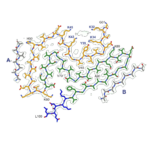
The groups of Michel Goedert and Sjors Scheres, from the LMB’s Neurobiology and Structural Studies Divisions, have used cryo-EM to identify identical structures of α-synuclein filaments from Parkinson’s disease and dementia with Lewy bodies.
MRC Laboratory of Molecular Biology
One of the world's leading research institutes, our scientists are working to advance understanding of biological processes at the molecular level - providing the knowledge needed to solve key problems in human health.